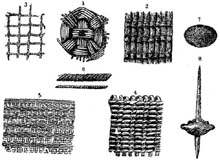What Is Weaving?
Answer:

Prehistoric woven objects and weaving tools.
|
Weaving is a textile craft in which two distinct sets of yarns or threads, called the warp and the filling or weft (older woof), are interlaced to form a fabric or cloth. The warp threads run lengthways on the piece of cloth, and the weft runs across from side to side, across the bolt of cloth.
Cloth is woven on a loom, a device that holds the warp threads in place while filling threads are woven through them. Weft is an old English word meaning "that which is woven".
The way the warp and filling threads interlace with each other is called the weave. The majority of woven products are created with one of three basic weaves: plain weave, satin weave, or twill.
Woven cloth can be plain (in one colour or a simple pattern), or can be woven in decorative or artistic designs, including tapestries. Fabric in which the warp and/or weft is tie-dyed before weaving is called ikat.
The ancient craft of handweaving, along with hand spinning, remains a popular craft. The majority of commercial fabrics in the West are woven on computer-controlled Jacquard looms. In the past, simpler fabrics were woven on dobby looms, while the Jacquard harness adaptation was reserved for more complex patterns. Some believe the efficiency of the Jacquard loom, with its Jacquard weaving process, makes it more economical for mills to use them to weave all of their fabrics, regardless of the complexity of the design.
|